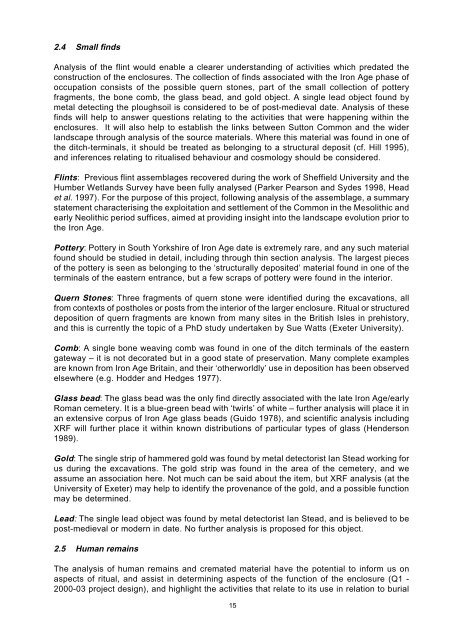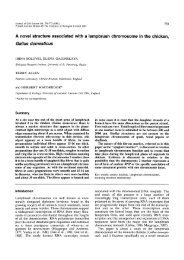Sutton Common Updated project design - University of Exeter
Sutton Common Updated project design - University of Exeter
Sutton Common Updated project design - University of Exeter
Create successful ePaper yourself
Turn your PDF publications into a flip-book with our unique Google optimized e-Paper software.
2.4 Small finds<br />
Analysis <strong>of</strong> the flint would enable a clearer understanding <strong>of</strong> activities which predated the<br />
construction <strong>of</strong> the enclosures. The collection <strong>of</strong> finds associated with the Iron Age phase <strong>of</strong><br />
occupation consists <strong>of</strong> the possible quern stones, part <strong>of</strong> the small collection <strong>of</strong> pottery<br />
fragments, the bone comb, the glass bead, and gold object. A single lead object found by<br />
metal detecting the ploughsoil is considered to be <strong>of</strong> post-medieval date. Analysis <strong>of</strong> these<br />
finds will help to answer questions relating to the activities that were happening within the<br />
enclosures. It will also help to establish the links between <strong>Sutton</strong> <strong>Common</strong> and the wider<br />
landscape through analysis <strong>of</strong> the source materials. Where this material was found in one <strong>of</strong><br />
the ditch-terminals, it should be treated as belonging to a structural deposit (cf. Hill 1995),<br />
and inferences relating to ritualised behaviour and cosmology should be considered.<br />
Flints: Previous flint assemblages recovered during the work <strong>of</strong> Sheffield <strong>University</strong> and the<br />
Humber Wetlands Survey have been fully analysed (Parker Pearson and Sydes 1998, Head<br />
et al. 1997). For the purpose <strong>of</strong> this <strong>project</strong>, following analysis <strong>of</strong> the assemblage, a summary<br />
statement characterising the exploitation and settlement <strong>of</strong> the <strong>Common</strong> in the Mesolithic and<br />
early Neolithic period suffices, aimed at providing insight into the landscape evolution prior to<br />
the Iron Age.<br />
Pottery: Pottery in South Yorkshire <strong>of</strong> Iron Age date is extremely rare, and any such material<br />
found should be studied in detail, including through thin section analysis. The largest pieces<br />
<strong>of</strong> the pottery is seen as belonging to the ‘structurally deposited’ material found in one <strong>of</strong> the<br />
terminals <strong>of</strong> the eastern entrance, but a few scraps <strong>of</strong> pottery were found in the interior.<br />
Quern Stones: Three fragments <strong>of</strong> quern stone were identified during the excavations, all<br />
from contexts <strong>of</strong> postholes or posts from the interior <strong>of</strong> the larger enclosure. Ritual or structured<br />
deposition <strong>of</strong> quern fragments are known from many sites in the British Isles in prehistory,<br />
and this is currently the topic <strong>of</strong> a PhD study undertaken by Sue Watts (<strong>Exeter</strong> <strong>University</strong>).<br />
Comb: A single bone weaving comb was found in one <strong>of</strong> the ditch terminals <strong>of</strong> the eastern<br />
gateway – it is not decorated but in a good state <strong>of</strong> preservation. Many complete examples<br />
are known from Iron Age Britain, and their ‘otherworldly’ use in deposition has been observed<br />
elsewhere (e.g. Hodder and Hedges 1977).<br />
Glass bead: The glass bead was the only find directly associated with the late Iron Age/early<br />
Roman cemetery. It is a blue-green bead with ‘twirls’ <strong>of</strong> white – further analysis will place it in<br />
an extensive corpus <strong>of</strong> Iron Age glass beads (Guido 1978), and scientific analysis including<br />
XRF will further place it within known distributions <strong>of</strong> particular types <strong>of</strong> glass (Henderson<br />
1989).<br />
Gold: The single strip <strong>of</strong> hammered gold was found by metal detectorist Ian Stead working for<br />
us during the excavations. The gold strip was found in the area <strong>of</strong> the cemetery, and we<br />
assume an association here. Not much can be said about the item, but XRF analysis (at the<br />
<strong>University</strong> <strong>of</strong> <strong>Exeter</strong>) may help to identify the provenance <strong>of</strong> the gold, and a possible function<br />
may be determined.<br />
Lead: The single lead object was found by metal detectorist Ian Stead, and is believed to be<br />
post-medieval or modern in date. No further analysis is proposed for this object.<br />
2.5 Human remains<br />
The analysis <strong>of</strong> human remains and cremated material have the potential to inform us on<br />
aspects <strong>of</strong> ritual, and assist in determining aspects <strong>of</strong> the function <strong>of</strong> the enclosure (Q1 -<br />
2000-03 <strong>project</strong> <strong>design</strong>), and highlight the activities that relate to its use in relation to burial<br />
15
















